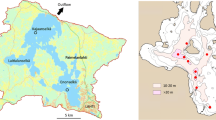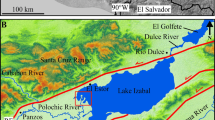Conclusions
-
1.
Hartbeespoort Dam is eutrophic with a low transparency — a condition which has developed during the past 25 years.
-
2.
Is is monomictic with complete circulation during the winter months, often resulting in low dissolved oxygen concentrations throughout the dam.
-
3.
The nutrient component of the water is obtained directly from the Jukskei-Crocodiel River and to a lesser degree from the Magalies River.
-
4.
Rises in pH in the epilimnion were mainly caused by the photosynthetic activity of the algae in the presence of moderately basic water.
-
5.
The bottom sediments in the deeper portion of the dam underwent rapid anaerobiasis after the establishment of a thermocline and oxyclinic in summer.
-
6.
The density of the fauna in the bottom sediments decreases rapidly with the establishment of the hypolimnion.
-
7.
The sediments are rich in iron and during summer there was an increase in the ferrous component. The soluble and acid soluble phosphorous increases in the hypolimnion after a winter minimum.
-
8.
Silica content is comparable with productive water masses in other parts of the world.
-
9.
The faunal associations are typical of other moderately basic and highly productive waters in the same geographical region of South Africa.
Similar content being viewed by others
XII. References
Cholnoky,B. J. -1958 -Hydrobiologische Untersuchungen in Transvaal II. Selbstreinigung im Jukskei-Crocodile Flusssystem.Hydrobiologia 11 (3: 4), 205–266.
Hasler,A. D. -1947 -Eutrophication of Lakes by domestic drainage.Ecology 28, 383–395.
Hutchinson,G. E.,G. L.Pickford &J. F. M.Schuurman - 1933 - A contribution to the hydrobiology of pans and other inland waters of South Africa.Arch. Hydrobiol. 24, 1–136.
Hutchinson,G. E. -1957 -A Treatise on Limnology, Vol. 1. John Wiley & Sons. Inc. New York.
Jaag,O. -1952 -Die Neuere Entwicklung unter dem heutigen Zustand Schweizerischer Gewasser — Gewasserschutz in der Schweiz.Das Gas and Wasserfach 93, (6), 1–8.
Jaag,O. -1953 -La crise des lacs et rivieres de l'Europe Centrale.Bull. Meis. die (B.E.D.E.) 37,157–160.
Keller,P. -1960 -Bacteriological aspects of pollution in the Jukskei-Crocodile River system in the Transvaal, South Africa. Hydrobiologia 14, (3: 4), 205–254.
Morgans,J. E. C. -1956 -Notes on the analysis of shallow — water soft substrata.,J. Anim. Ecol. 25 (2), 367–387.
Mundie,J. H. -1957 -The ecology of Chironomidae in storage and reservoirs.Trans. Roy. ent. Soc. Lond. 109 (5), 149–232.
Welch,P. S. -1948 -Limnological Methods. The Blakiston Company, Philadelphia.
Welch,P. S. -1952 -Limnology. McGraw-Hill Book Company Inc. New York.
Author information
Authors and Affiliations
Rights and permissions
About this article
Cite this article
Allanson, B.R., Gieskes, J.M.T.M. Part II An introduction to the limnology of Hartbeespoort Dam with special reference to the effect of industrial and domestic pollution. Hydrobiologia 18, 77–94 (1961). https://doi.org/10.1007/BF00731364
Issue Date:
DOI: https://doi.org/10.1007/BF00731364




